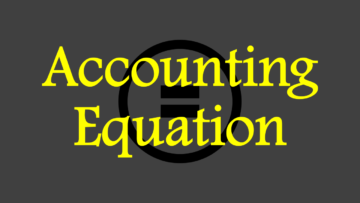Before understanding accounting equation, we must understand the meaning of the words accounting and equation because it is a combination of both.
Accounting: Accounting refers to the management of economic transactions and in this, the transactions are managed by a process which includes identification, measurement, recording, classification, summary, etc. It includes many rules, concepts, principles, etc. which help in managing the transactions like double entry system, rules of debit and credit, etc. By managing the transactions as per the rules of debit and credit and double entry system the liabilities and assets are equal to each other which can be seen in the balance sheet.
Equation: An equation is a statement (formula) that expresses the equality of two expressions by joining them with an equal sign. In simple terms, it is a statement that has an equal sign and there are some values on either side of the sign and the values on both sides are equal to each other. It is used where it has to be shown that the values on both sides are equal to each other. Examples are described below:
| Situation – 1 | Situation – 2 | Situation – 3 |
| A = B | A + B = C | A = B + C |
| 10 = 10 | 5+5 = 10 | 10 = 8+2 |
| 10 = 10 | 10 = 10 | 10 = 10 |

Table of Contents
What is Accounting Equation?
The accounting equation is a statement (formula) used in accounting to show that assets and liabilities or debits and credits are equal. This equation has an equal sign and values on both sides such as asset = liability, debit = credit, etc. This equation in accounting proves that assets are equal to liabilities or liabilities are equal to assets and debits are equal to credits or credits are equal to debits.
| Accounting Equation |
| (A = L + E) Assets = Liabilities + Equity (Owner’s Share) |
The accounting equation is also called the balance sheet equation because according to it the balance sheet is prepared, or it is prepared according to the balance sheet. It can be easily understood through the balance sheet because there are two sides in the balance sheet, one is a liability and the other is an asset which is equal to each other.
Note: The owner’s share comes under liability as it is an obligation for the business which has to be paid.
In simple words, a business does not have anything of its own, it takes assets from someone else, and the asset taken becomes a liability for it, that is why the liability is equal to the asset or the asset is equal to the liability, and this is what the accounting equation proves.
Features of Accounting Equation
Following are the features of accounting equation:
1. Statement:
It is a statement that proves that the asset is equal to the liability, or the liability is equal to the asset, and this is possible because when an asset comes, the liability also comes and when an asset goes, the liability also goes. In simple language, every transaction has two sides, one is debit and the other is credit in which one side decreases something and the other increases something, or both sides increase something, or both sides decrease something, etc., due to which the asset and liability remain in balance.
2. Equal:
There is an equal sign in the middle of this equation and there are some values on both sides that are equal to each other like liability = asset or asset = liability, etc. For example, a business has assets of Rs. 1,00,000/- and liabilities of Rs. 75,000/- and owner’s share of Rs. 25,000/- then in this case:
| Assets = Liabilities + Equity (Owner’s Share) |
| 1,00,000/- = 75,000/- + 25,000/- (On separation of the owner’s share) 1,00,000/- = 1,00,000/- (Including Owner’s Share) |
3. Error Checker:
It acts like an error checker as both sides are equal only when there is no error in the accounting work, if there is an error in the accounting work then both sides are not equal. Accounting equation can be seen in the balance sheet as the balance sheet is prepared according to it or it is prepared according to the balance sheet.
4. Scientific:
The accounting equation is scientifically proven because every transaction has two sides that ultimately become equal to each other, for example, asset equals liability or liability equals asset, or debit equals credit or credit equals debit, etc.
5. Universal:
It is universal as it is found wherever proper accounting is used because in proper accounting all the relevant rules, concepts, principles, etc. are systematically used which makes debit equal to credit or credit equal to debit, or asset equal to liability or liability equal to asset.
Read Also:
QNA/FAQ
Q1. What is accounting equation?
Ans: An accounting equation is a statement (formula) that proves that assets equal liabilities or liabilities equal assets and debits equal credits or credits equal debits.
Q2. By what other name is the accounting equation also known?
Ans: The accounting equation is also known as the balance sheet equation.
Q3. Does the accounting equation have an equals sign?
Ans: Yes, there is an equal sign in the accounting equation.
Q4. Does the accounting equation show that assets and liabilities are equal?
Ans: Yes, the accounting equation shows that assets and liabilities are equal to each other.
Q5. Write the features of the accounting equation.
Ans: Following are the features of accounting equation:
1. It is a statement.
2. It’s both sides are equal.
3. It is universal.
4. It acts as an error checker.
5. It is scientifically proven.
6. It helps to management.













